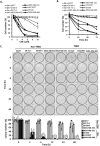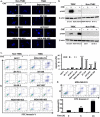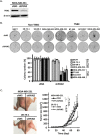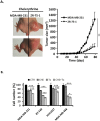Protein kinase C inhibitor chelerythrine selectively inhibits proliferation of triple-negative breast cancer cells
- PMID: 28515445
- PMCID: PMC5435721
- DOI: 10.1038/s41598-017-02222-0
Protein kinase C inhibitor chelerythrine selectively inhibits proliferation of triple-negative breast cancer cells
Abstract
Triple-negative breast cancer (TNBC) is a subtype of breast cancer lacking targeted therapy currently. Recent studies imply that protein kinase C may play important roles in TNBC development and could be a specific target. In this study, we evaluated the anti-proliferative activity of PKC inhibitor chelerythrine on a panel of breast cancer cell lines. Chelerythrine selectively inhibited the growth of TNBC cell lines compared to non-TNBC cell lines as demonstrated by in vitro cell proliferation assay and colony formation assay, as well as evidenced by in vivo xenograft assay. The selective anti-proliferative effect of chelerythrine was associated with induction of apoptosis in TNBC cell lines. We further demonstrated that PKN2, one of the PKC subtypes, was highly expressed in TNBC cell lines, and knocking down PKN2 in TNBC cells inhibited colony formation and xenograft growth. This indicates that PKN2 is required for the survival of TNBC cells, and could be the target mediates the selective activity of chelerythrine. Finally, combination of chelerythrine and chemotherapy reagent taxol showed synergistic/additive effect on TNBC cell lines. Our results suggest chelerythrine or other PKC inhibitors may be promising regimens for TNBC tumors.
Conflict of interest statement
The authors declare that they have no competing interests.
Figures





Similar articles
-
PRKCQ promotes oncogenic growth and anoikis resistance of a subset of triple-negative breast cancer cells.Breast Cancer Res. 2016 Sep 23;18(1):95. doi: 10.1186/s13058-016-0749-6. Breast Cancer Res. 2016. PMID: 27663795 Free PMC article.
-
Histone Deacetylase Inhibitor Enhances the Efficacy of MEK Inhibitor through NOXA-Mediated MCL1 Degradation in Triple-Negative and Inflammatory Breast Cancer.Clin Cancer Res. 2017 Aug 15;23(16):4780-4792. doi: 10.1158/1078-0432.CCR-16-2622. Epub 2017 May 2. Clin Cancer Res. 2017. PMID: 28465444 Free PMC article.
-
Mithramycin A suppresses basal triple-negative breast cancer cell survival partially via down-regulating Krüppel-like factor 5 transcription by Sp1.Sci Rep. 2018 Jan 18;8(1):1138. doi: 10.1038/s41598-018-19489-6. Sci Rep. 2018. PMID: 29348684 Free PMC article.
-
Effects of sanguinarine and chelerythrine on the cell cycle and apoptosis.Biomed Pap Med Fac Univ Palacky Olomouc Czech Repub. 2006 Jul;150(1):5-12. doi: 10.5507/bp.2006.001. Biomed Pap Med Fac Univ Palacky Olomouc Czech Repub. 2006. PMID: 16936897 Review.
-
Recent advancement in developing small molecular inhibitors targeting key kinase pathways against triple-negative breast cancer.Bioorg Med Chem. 2024 Oct 1;112:117877. doi: 10.1016/j.bmc.2024.117877. Epub 2024 Aug 18. Bioorg Med Chem. 2024. PMID: 39159528 Review.
Cited by
-
Rediscovery of Traditional Plant Medicine: An Underestimated Anticancer Drug of Chelerythrine.Front Pharmacol. 2022 Jun 1;13:906301. doi: 10.3389/fphar.2022.906301. eCollection 2022. Front Pharmacol. 2022. PMID: 35721116 Free PMC article. Review.
-
Comprehensive Proteomic Characterization Reveals Subclass-Specific Molecular Aberrations within Triple-negative Breast Cancer.iScience. 2020 Feb 21;23(2):100868. doi: 10.1016/j.isci.2020.100868. Epub 2020 Jan 28. iScience. 2020. PMID: 32058975 Free PMC article.
-
Opportunities and Challenges for the Development of MRCK Kinases Inhibitors as Potential Cancer Chemotherapeutics.Cells. 2023 Feb 7;12(4):534. doi: 10.3390/cells12040534. Cells. 2023. PMID: 36831201 Free PMC article. Review.
-
Chelerythrine Attenuates the Inflammation of Lipopolysaccharide-Induced Acute Lung Inflammation Through NF-κB Signaling Pathway Mediated by Nrf2.Front Pharmacol. 2018 Sep 26;9:1047. doi: 10.3389/fphar.2018.01047. eCollection 2018. Front Pharmacol. 2018. PMID: 30319404 Free PMC article.
-
A Potential Anticancer Mechanism of Finger Root (Boesenbergia rotunda) Extracts against a Breast Cancer Cell Line.Scientifica (Cairo). 2022 Sep 5;2022:9130252. doi: 10.1155/2022/9130252. eCollection 2022. Scientifica (Cairo). 2022. PMID: 36106139 Free PMC article.
References
-
- IARC, W. GLOBOCAN: Estimated Cancer Incidence, Mortality, and Prevalence Worldwide in 2012 (IARC, 2014).
-
- Brenton JD, Carey LA, Ahmed AA, Caldas C. Molecular classification and molecular forecasting of breast cancer: ready for clinical application? Journal of clinical oncology: official journal of the American Society of Clinical Oncology. 2005;23:7350–7360. doi: 10.1200/JCO.2005.03.3845. - DOI - PubMed
Publication types
MeSH terms
Substances
LinkOut - more resources
Full Text Sources
Other Literature Sources

